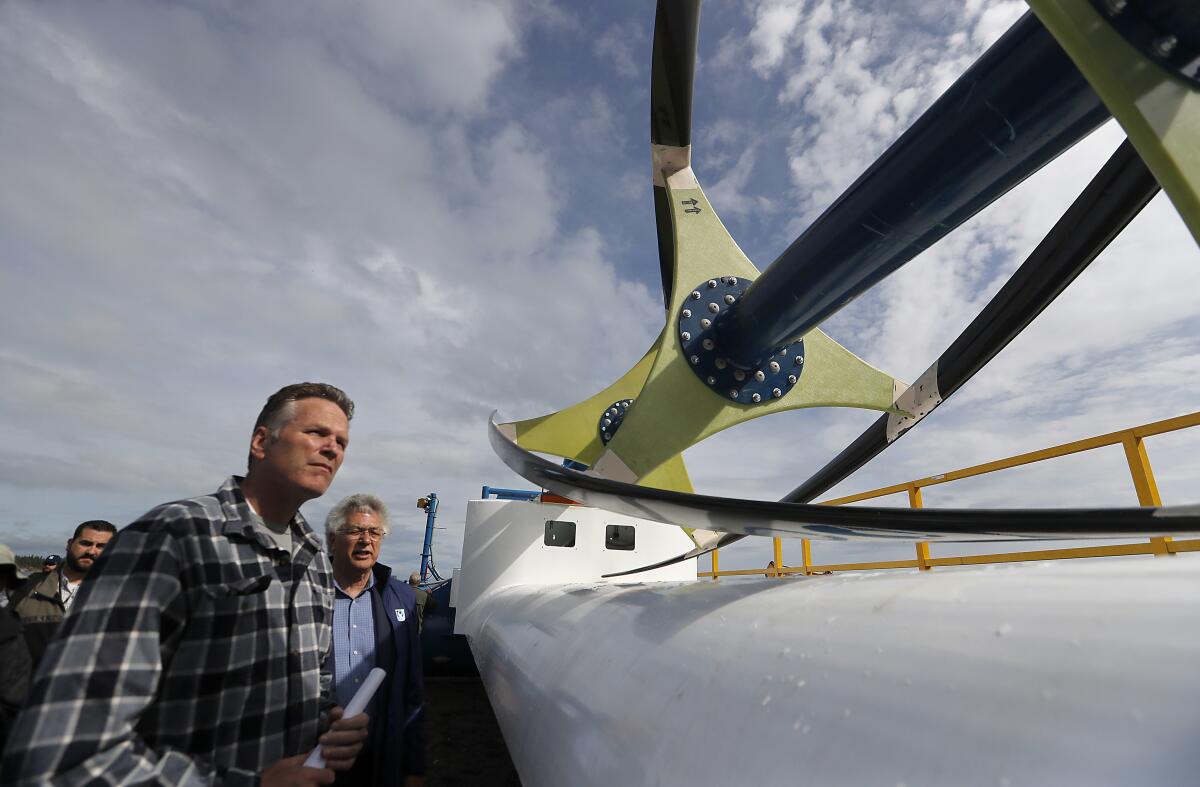Alaska is reeling from budget cuts, even as governor wants to pay each resident $3,000

- Share via
NAKNEK, Alaska — For the hundreds of salmon fishing crews plying Bristol Bay during this summer’s sockeye season, public radio station KDLG is essential listening.
They tune into 670 AM each evening for bulletins on the shifting boundaries of the fishery. Then there are the more personal messages.
“Hey, Kyle, congratulations, you are an uncle. July 3. Healthy 7.5-pounder. Lyndsi was early and did great. Love, Pops.”
“To Glenn Gustavson on the fishing vessel Intimidator, I miss you dearly. I sent you and Grant a care package of oatmeal and chocolate chip cookies, but it was returned, melted. Love Yours, Jenny G.”
The fisheries report is often the only reliable contact that many crews have with land.
Now it is in jeopardy — along with many other services that help knit together a thinly populated state with more coastline than the continental United States.
Through line-item vetoes, Republican Gov. Mike Dunleavy has cut $444 million from the $8.3-billion state operating budget that took effect July 1. His targets included the $2.7 million that the state would have provided Alaska’s 27 public radio and television stations, along with much of the funding for food banks, senior citizens and the public university system.
The cuts are his way of making good on a campaign pledge that helped get him elected in November: paying each resident $3,000 a year from the Permanent Fund, the state’s famed savings account built on oil revenue.
The Alaskan economy runs on oil and has taken a serious hit over the last five years as crude prices have fallen. Rather than introduce a state sales tax or a personal income tax, legislators reduced payments from the fund. Last year each qualifying Alaskan received $1,600.
Under the governor’s plan, total annual payouts would nearly double to $1.9 billion.
The money had to come from somewhere. In the view of many residents of this staunchly conservative state, private citizens can spend the money better than the government.
But the budget cuts have thrown Alaska into turmoil.
Managers of food banks, radio stations and universities are finding that losses amount to more than the face value of state funding.
Many hard-pressed seniors who accept the $3,000 dividend will lose eligibility for monthly, federally funded 50-pound food boxes.
LouAnne Carroll-Tysdal, who runs the Upper Susitna Food Pantry in Talkeetna, population 875, described panic among elderly residents over the cancellation of a state senior benefits program that provided up to $275 a month. More than 40% of the families the nonprofit food bank serves have no running water, and many live beyond the road system without electricity.
“I hate the fact that without the senior benefit, people have to choose between food and medication,” she said. “I don’t believe that taking services from people will get them to go to work. I do believe it will make them hungry.”
Likewise, ending state support for the radio stations has jeopardized their eligibility for federal funding, said Mollie Kabler, Alaska Public Broadcasting executive director.
While vast reaches of the state lack phone or internet service, Kabler said that nearly all of Alaska’s 737,000 residents have access to public radio, which not only provides their news but also broadcasts emergency alerts.
When a wildfire broke out in Talkeetna this month, KTNA’s lone reporter began broadcasting news about the fire two hours before state officials issued an emergency alert to all cellphones in the area.
Alaska’s state university system is reeling from a 41% budget cut, which prompted Moody’s Wednesday to downgrade its credit rating.
Jim Johnsen, the system’s president, called the funding cut “extremely debilitating” and said the damage would be long-lasting. State funds are the system’s “seed-corn money,” he said, used to pay professors to teach classes that generate tuition, researchers who win grants and development officers who bring in donations.
“We’re already a couple weeks into the fiscal year and our burn rate is unsustainable, so every day we don’t make decisions, we have to cut later in the year,” he said.
The university system’s Board of Regents has been considering whether to declare financial exigency, a move short of bankruptcy that would allow rapid cuts of programs and professors including tenured faculty.
Maria Williams, who represents professors as head of the system’s Faculty Alliance, said making that move too soon could cause panic, scaring off students and jeopardizing accreditation. “It’s basically like martial law once that’s declared,” she said. “They could close an entire campus, and it doesn’t matter anymore if faculty have tenure.”
Dunleavy has said he believes that future increases in oil production on the North Slope will eventually pull Alaska out of its fiscal jam.
Some legislators say he may be playing chicken, angling for a compromise.
The legislators opposing the cuts include some Republicans. State Sen. Natasha von Imhof accused the governor of “purposely throwing Alaska into a severe economic recession.” But they have been unable to summon the three-quarters majority required to override the vetoes.
Earlier this month, feuding factions gathered in separate locations. This week, Dunleavy called all 20 state senators and 40 state House members to the capital, Juneau, where they began meeting on Thursday.
That raised hopes that the two sides would negotiate to reduce the oil payout slightly and undo some of the cuts.
Back at KDLG, which broadcasts from the coastal town of Dillingham in southwest Alaska, reporter Alex Hager was preparing the day’s fisheries report, which reaches about 15,000 listeners in an area the size of Ohio.
One of them, a commercial fisherman, recently explained to Hager why he appreciates the broadcast.
“It’s a great opportunity to hear someone’s voice who’s not one of my crew members,” he said.
More to Read
Sign up for Essential California
The most important California stories and recommendations in your inbox every morning.
You may occasionally receive promotional content from the Los Angeles Times.














